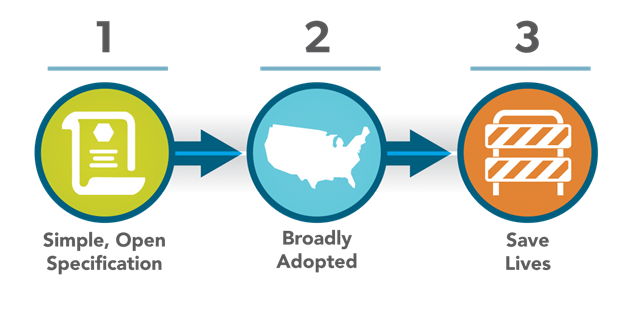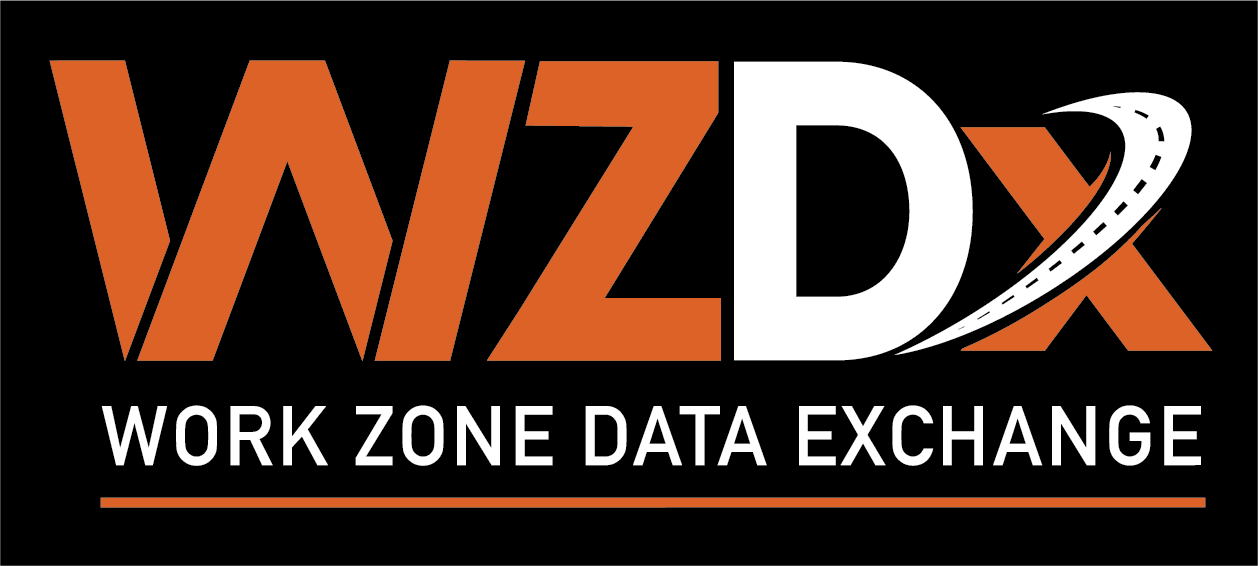Work Zone Data Exchange (WZDx)
Latest News
- The Work Zone Data Working Group released version 4.0 of the WZDx Specification in December 2021. This update reorganizes the feed to make room for smart work zone device data and non-work zone road restrictions as well as permitting road owners to share more nuanced information about worker presence in work zones.
- The latest semi-annual meeting of the Work Zone Data Working Group took place on November 2, 2021. Notes and the slide deck from the meeting are available on the WZDx GitHub Wiki website, along with a recording of the meeting.
- A video recording of the WZDx presentation at the 2021 Virtual National Work Zone Management Conference on October 19, 2021 is available here.
- The presentation slides from the April 29, 2021 WZDx webinar including the Wisconsin DOT project are available here.
Overview
The Work Zone Data Exchange (WZDx) Specification enables infrastructure owners and operators (IOOs) to make harmonized work zone data available for third party use. The intent is to make travel on public roads safer and more efficient through ubiquitous access to data on work zone activity. Specifically, the project aims to get data on work zones into vehicles to help automated driving systems (ADS) and human drivers navigate more safely.

WZDx Demonstration Grants
The U.S Department of Transportation (U.S. DOT) awarded $2,372,254 on January 15, 2021 for Work Zone Data Exchange (WZDx) Demonstration Grants to fund 13 projects in 13 States. The Notice of Funding opportunity (NOFO) for this WZDx Demonstration closed on August 3, 2020. The purpose of this research program is to increase the safety of the traveling public through the production of consistent public work zone data feeds across jurisdictions. This was a one-time funding opportunity for public roadway operators to make unified work zone data feeds available for use by third parties and collaborate on the WZDx Specification development.
WZDx Specification
Available WZDx Data Feeds
Active WZDx data feeds can be found on the WZDx Feed Registry. The registry currently lists feeds from the following jurisdictions:
- Texas Department of Transportation
- Iowa Department of Transportation
- Maricopa County (Arizona) Department of Transportation
- Massachusetts Department of Transportation
- North Carolina Department of Transportation
Check the registry for the latest information on available feeds. New feeds are added as they become available. To inquire about adding a new feed to the WZDx Feed Registry, please email avdx@dot.gov.
Why is the WZDx Specification being developed?
Improving access to work zone data is one of the top needs identified through the USDOT's Data for Automated Vehicle Integration (DAVI) initiative.
Up-to-date information about dynamic conditions occurring on roads – such as construction events – can help ADS and humans navigate safely and efficiently. Many IOOs maintain data on work zone activity. However, a lack of common data standards and convening mechanisms makes it difficult and costly for third parties – including original equipment manufacturers (OEMs) and navigation applications – to access and use these data across various jurisdictions.
Inspired by the General Transit Feed Specification (GTFS), USDOT launched the WZDx Specification to jumpstart the voluntary adoption of a basic work zone data specification through collaboration with data producers and data users. Longer term, the goal is to enable collaborative maintenance and expansion of the specification to meet the emerging needs of ADS.
More broadly, through this project, USDOT aims to identify a repeatable approach to accelerate harmonization of local data sources that can improve roadway safety and efficiency.
Who is involved in developing WZDx?
The Federal Highway Administration (FHWA) and Intelligent Transportation Systems Joint Program Office (ITS JPO) co-led the early stages of the WZDx project and remain actively involved along with the Bureau of Transportation Statistics (BTS), Federal Motor Carrier Safety Administration (FMCSA), and others in the USDOT. Several data producers and data users voluntarily developed version 1.1 of the specification in collaboration with USDOT and have started to set up data feeds based on it.
In 2019, the Work Zone Data Working Group (WZDWG) was established under the Federal Geographic Data Committee (FGDC) Transportation Subcommittee with the primary goal of developing version 2 of the WZDx Specification based on lessons learned from version 1.1 and new insights from the user community. Version 2 of the Work Zone Data Exchange (WZDx) Specification was released in early 2020. Several data producers have already established WZDx feeds based on version 2:
In April 2021, the WZDWG published version 3.1 of the WZDx Specification. Changes made to the WZDx specification for v3.1 sought to enhance the usability of the specification without making major changes or breaking backwards compatibility. The proposed changes were approved in late March of 2021 and were merged into the specification to form WZDx version 3.1.
In December 2021, the WZDWG published version 4.0 of the WZDx Specification. This version breaks backwards compatibility to reorganize the feed to allow data producers to publish new feeds for smart work zone device data and non-work zone road restrictions, as well as to remove several depreciated values. A summary of the changes is below.
- Addition of two new feed types: one for smart work zone device data and one for road restrictions not caused by work zone activity, in addition to the existing WZDx feed for work zones and detours.
- Reorganization of the specification to include other types of temporary road closures, restrictions, and relevant events.
- Creation of a new object to contain more information about the presence of workers in a work zone, such as a data producer's confidence that workers are present.
- Allowing feeds to provide more information at the road event-level when lane-level information is not available, such as restriction values, merges, and shifts.
- Streamlining lane types to remove references to position and add missing values.
- Deprecation of unused properties and removal of previously deprecated properties and values.
Several resources for work zone data producers are available on the WZDx project website:
- The Institutional Buy-In Paper is a three-page informational document produced by the co-chairs of the Technical Assistance Subgroup in Fall 2021. The document is geared towards data producers and addresses a series of commonly asked questions and concerns about developing a WZDx feed. The document has a companion Institutional Buy-In Presentation, which covers the same material in a PowerPoint format.
- The Early Adopters' Guide was developed out of a series of interviews conducted in Fall 2020 by the co-chairs of the Technical Assistance Subgroup. The guide includes lessons learned, challenges faced, and steps taken by several DOTs to implement their WZDx feeds and is intended to assist new adopters.
- The Work Zone Data Working Group published the Work Zone Data Survey Report on GitHub in Spring 2021. The report analyzes the current state of practice for collecting, publishing, and using real-time data about worker presence in work zones.
Visit the WZDx project site for more information, to set up or ingest a feed, and/or to provide feedback on the specification.
WZDx Partnership and Awareness Campaign: Put Work Zones on the Map
The purpose of the partnership and awareness campaign is to educate and engage potential partners on the capabilities, benefits and progress of the Work Zone Data Exchange (WZDx). This effort is designed to work in tandem with the National Work Zone Awareness Week (NWZAW) campaign. While NWZAW targets the general public, the WZDx campaign is focused on audiences who directly engage with work zones: infrastructure owner operators (IOOs) who own and manage the roadways, construction companies conducting work on the roadways, mapping companies looking for data to inform their products, and original equipment manufacturers (OEMs) that develop automated vehicles and equipment that will benefit from improved digital data about active work zones.
The campaign aims to work alongside these groups and to implement stakeholder outreach, develop and distribute educational materials, raise awareness for pilot projects, increase involvement in the Work Zone Data Working Group, and generate excitement for WZDx — to ultimately encourage and facilitate adoption of the WZDx Specification.
WZDx Put Work Zone on the Map Outreach Toolkit
Work Zone Data Initiative (WZDI)
FHWA is leading efforts, via the Work Zone Data Initiative (WZDI), to develop a standard approach for collecting, organizing, and sharing data on the "when," "where," and "how" of work zone deployment. The goal of this national initiative is to create and accelerate the adoption of a consistent language for communicating work zone activity data across jurisdictional and organizational boundaries. Adoption of this common language will result in enhanced work zone management practices leading to improved mobility and safety in and around work zones for both workers and the traveling public.
First-level support for questions regarding WZDx specifications has been integrated into the USDOT Connected and Automated Vehicle Support Services Help Desk. Our experts can connect you to the answers you need as you work to make travel on public roads safer and more efficient through ubiquitous access to data on work zone activity. For assistance or questions about setting up a WZDx data feed, please contact WZDxSupport@dot.gov.
WZDI Case Studies
As the nation develops an increasing reliance on technology and next generation transportation management, ensuring the availability of consistent, reliable data describing work zone events is critical to enabling agency management of highway operations. The FHWA is leading the WZDI to improve the availability of information on work zone events—the "when, where, and how" of highway construction activity—by promoting standards and processes that enhance agency capabilities to manage transportation operations around work zones and enable sharing this valuable information with other transportation operations stakeholders.
- Planning, Developing, and Implementing A Centralized Work Zone Data Hub—Iowa Department Of Transportation
- Utilizing Work Zone Event Data in Connected And Smarter Work Zone Applications—Maricopa County, Arizona
For information on the WZDx project, WZDI, or anything else related to the DAVI initiative, please contact AVDX@dot.gov.

